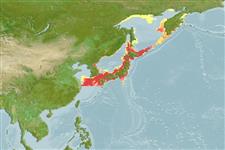Common names from other countries
Classification / Names / Names
俗名 | 同种异名 | Catalog of Fishes (gen., sp.) | ITIS | CoL | WoRMS
Environment: milieu / climate zone / depth range / distribution range
生态学
; 深度上下限 0 - 200 m (Ref. 635), usually 50 - 100 m (Ref. 635). ? - 30°C (Ref. 77134), preferred 16°C (Ref. 107945); 63°N - 31°N, 117°E - 165°E (Ref. 112755)
分布
国家 | FAO区域 | 生态系 | 标本纪录 | 简介
Northwest Pacific: Japan (from Hokkaido to Kyushu), China, Korean Peninsula and Far Eastern Russia (Karaginskogo Island).
Length at first maturity / 大小 / 重量 / 年龄
Maturity: Lm ?, range 20 - ? cm Max length : 30.0 cm TL 雄鱼/尚未辨别雌雄; (Ref. 101467)
Common in shallow coastal bottom communities from the intertidal zone to depths more than 100 m. Forms aggregations, usually in the upper sublittoral zone (Ref. 635). May occur in three color variants: red type often found in offshore gravel beds while the green and black types often at inshore sandy-muddy bottoms (Ref. 77132). Juveniles often associated with algal/seagrass and oyster beds (Ref. 621). Most commercially important sea cucumber species (for trade, food and traditional medicine both; fisheries and farming/ranching) in China (Ref. 77133). Aquaculture now widespread in northern coast of China (Ref. 77133) since wild populations became over-exploited in the 1990s. Chinese aquaculture production peaked at 65,283 tons in 2005 (Ref. 77133).
Life cycle and mating behavior
成熟度 | 繁殖 | 产卵场 | 卵 | 孕卵数 | 仔鱼
Members of the class Holothuroidea are gonochoric and have only one gonad. Spawning and fertilization are both external and some exhibit brooding. Life cycle: Embryos develop into planktotrophic larvae (auricularia) then into doliolaria (barrel-shaped stage) which later metamorphose into juvenile sea cucumbers.
主要参考文献
参考文献 | 合作者 | 合作者
Kan-no, M. and A. Kijima. 2003. (Ref. 77132)
世界自然保护联盟红皮书 (Ref. 130435: Version 2024-1)
濒危 (EN) (A2bd); Date assessed: 19 May 2010
Not Evaluated
Not Evaluated
对人类的威胁
人类利用
渔业: 商业性; 养殖: 商业性
FAO - 养殖: 产生, 物种外形; 渔业: landings | FishSource | 周边海洋
工具
网络资源
Estimates based on models
Preferred temperature
(Ref.
115969): 8.6 - 19.7, mean 15.2 (based on 30 cells).
脆弱性
Low to moderate vulnerability (35 of 100).
